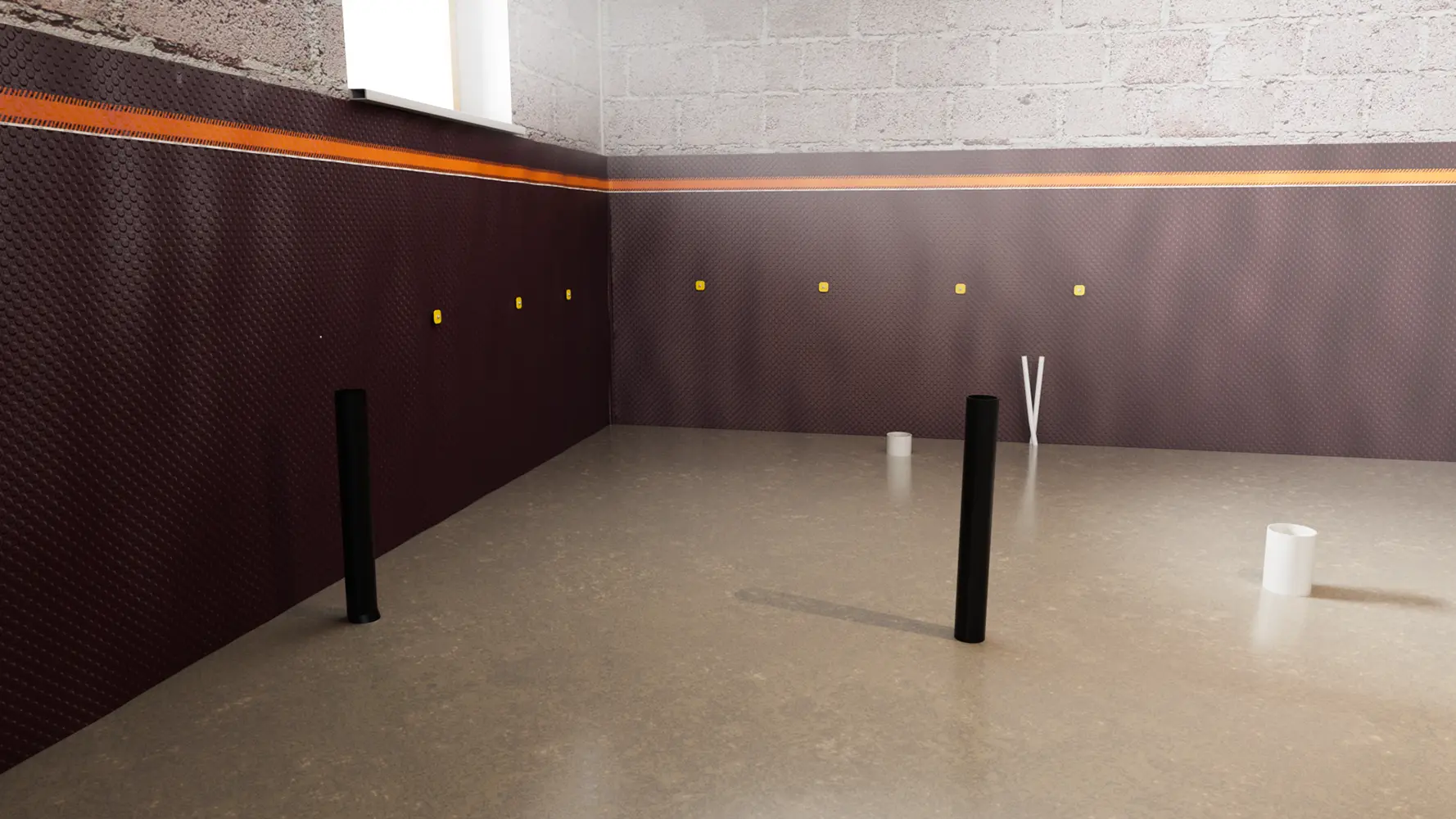Moisture in the basement is not just a nuisance, but also a health hazard for household members. Basement areas often become damp due to their location below ground level and closeness to groundwater. This, in turn, leads to the growth of mold, not to mention stagnant water, which can damage certain parts of the basement and render them unusable.
Did you know that approximately 38% of basements affected by moisture also experience problems with mold and fungus growth? This adversely impacts human health and can lead to illnesses! To protect yourself and your family from this issue, take steps for waterproofing basement walls in advance.
Understanding Basement Water Problems
Let’s delve deeper into the troubles caused by moisture in the basement to better understand how to tackle them. Of course, the first sign that you urgently need basement wall waterproofing is the water on the floor. However, there are more tricky signs that may not immediately catch your eye. For example:
- Excessive condensation on ducts and pipes.
- Discolored or soft drywall, which serves as wall covering.
- An unpleasant and musty odor in the room.
- Rotten wood in window frames, as well as water stains on walls around windows.
- Damp and humid air.
It’s important to determine where the moisture is coming from: outside or if it’s condensation forming inside the basement. You can investigate this yourself.
Simply take a piece of aluminum foil and attach it to the basement wall, leaving it for a few days. Then, inspect the foil from both sides. If moisture is on the side facing the room, then you’re dealing with condensation. If the wet side, which was in contact with the wall, indicates infiltration. In either case, waterproofing basement Toronto is necessary.
Evaluating and Preparing the Basement
Before starting the waterproofing of basement walls, it’s necessary to analyze the scope of work. First, assess the type of foundation. If it’s made of slag blocks, you’ll need to use different methods to seal basement walls than those for poured concrete. Next, perform a detailed inspection of the walls.
Inspecting Basement Walls for Damage
Try to find the source of water intrusion in the basement. Thoroughly check pipes, joints, window openings, and other vulnerable areas. Some cracks and gaps may be detected immediately. But remember that concrete is a porous material, so water can seep through it, leaving damp streaks on the walls. More extensive moisture problems lie in the improper planning of the house facade, faulty plumbing, as well as clogged gutters and downspouts.
Addressing Efflorescence and Mold Issues
Efflorescence is a powdery white substance that appears on unfinished concrete walls and floors. In other words, it’s a buildup of minerals and salts formed as water evaporates. Removing it is extremely challenging, but it’s possible by using hydrochloric acid and a wire brush.
Before applying a basement wall sealer, you need to remove all mold. Discard and dispose of damaged drywall, textiles, and other porous materials affected by mold. Then, apply a special spray to the concrete to fight mold.
Eliminating Accumulated Water
If there is stagnant water in the basement, it should be pumped out before patching cracks. Otherwise, there’s a risk of electric shock when using power tools. After pumping out the water, the basement floor must fully dry out for subsequent professional waterproofing.
When is the Ideal Time to Seal Basement Walls?
The most suitable time for waterproofing interior basement walls is when the basement is still under construction. This will allow you to smoothly carry out all the installation work for the waterproofing system and overall sealing of basement walls. But don’t despair if you missed this window, as it’s never too late to waterproof the basement walls!
Plan the work for the summer! Dry weather and positive temperatures are ideal for this task, especially if soil excavation around the house perimeter is required. Additionally, sealants and protective coatings dry faster in the summer. In winter, frozen ground may be an issue, significantly complicating the process of waterproofing basement walls from the inside.
Varieties of Waterproof Coatings
The most popular and effective materials to waterproof basement walls are epoxy, polyurethane, and hydraulic cement. The latter is cheaper, but serious issues with wet basement walls are better addressed with polyurethane and epoxy resin. Let’s discuss more specifically what can bring the best result.
Plastic Sheets and Waterproof Panels
The material used for panels and sheets is non-porous, so it doesn’t swell under moisture and, as a result, doesn’t rot. However, there’s a catch: it works best with a basement drainage system.
Silicate Concrete Sealant
These sealants penetrate the upper layers of concrete, where a chemical reaction occurs. This forms a permanent barrier inside the pores, increasing the strength and water resistance of the surface.
Waterproof Concrete Coatings
It is applied in thick layers and firmly bonds with the concrete surface, leaving no chance for moisture to seep through the material.
Interior Waterproofing Paint
Waterproof paint is often used not so much by professionals as by homeowners who are interested in how to waterproof basement walls themselves. This type of coating resembles regular wall paint: it can be applied with a roller or brush and sprayed on almost any surface.
How to Waterproof Basement Walls
Let’s break down this process step by step.
1. Remove Any Standing Water
Get rid of any standing water by pumping it out of the basement, then ensure the area is completely dry. Otherwise, any remaining water can obscure the leak’s source. If it’s the floor rather than the wall, you will need different solutions.
2. Identify the Source of the Leak
Carefully inspect the seams, pipes, and window openings for cracks—moisture may enter your basement through them. If didn’t find any internal causes, look for the problem outside the basement.
3. Clean and Prepare the Area
Prepare the walls by scrubbing them with a dry brush and removing debris and dirt. Remove efflorescence from the stone masonry by cleaning it with muriatic acid. Then, treat the surface with acetone and a wire brush to strip the paint from the walls. Rinse the surface and repeat several times until no trace of paint remains.
4. Seal Holes and Cracks
You can use epoxy resin, sealant, or hydraulic cement. Simply insert the chosen sealant into a caulking gun and fill the crack flush with the wall surface.
5. Re-seal Doors, Windows, and Window Wells
The joints and openings in window and door frames should also be filled with sealant. To do this, insert the tip of the caulking gun into the gap and run the sealant along the entire length of the gap in a straight line.
6. Apply Waterproof Coating
Apply a silicate concrete sealant with a sprayer or roller in two to three coats, allowing each coat to dry for 10-20 minutes. Then, remove any excess material. You will need a mop to apply waterproof concrete coating since the material is more flexible. Waterproofing paint is the final step for the best level of protection for foundation walls.
Professional versus DIY Basement Waterproofing
Waterproofing basement walls can be done DIY but requires technical skills, knowledge, and special equipment.
For a more effective result, it’s better to turn to professionals who can promptly identify the cause of moisture on basement walls and eliminate it faster and more efficiently.
Conclusion
Moisture on basement walls poses a significant problem for homeowners and their families, as it promotes the growth of mold and mildew indoors, negatively impacting health and well-being.
If you’re experiencing this issue, don’t delay. Contact Quality Age Build for basement wall waterproofing! Our specialists will perform all the necessary work promptly and efficiently so you can finally forget about moisture on your basement walls.
Contact us
Quality Age Build Inc is at your service across the GTA. Request a quote today and ensure your property is in expert hands.
Related Services
Pair our expert guidance with our waterproofing solutions to eliminate leaks, control moisture, and keep your basement dry and healthy.
FAQs
How long does waterproof sealing work on basement walls?
It depends on how well the basement wall waterproofing was done. On average, it lasts about 10 years, but in some cases, it can last longer.
How can homeowners identify signs of water damage on basement walls?
Signs include condensation buildup on pipes and ducts, musty and unpleasant odors in the room, damp and humid air, as well as rotted wood in window frames and softened drywall on walls.
What preventive measures can homeowners take to avoid water damage in the future after waterproofing?
Timely identify and fix leaks, seal cracks and holes in windows, doors, and the foundation, and ensure good ventilation in the basement.

